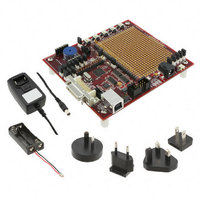EM260-BBRD-128K-USART-R Ember, EM260-BBRD-128K-USART-R Datasheet - Page 15

EM260-BBRD-128K-USART-R
Manufacturer Part Number
EM260-BBRD-128K-USART-R
Description
EM260 BREAKOUT BOARD
Manufacturer
Ember
Type
Transceiver, 802.15.4/ZigBeer
Datasheet
1.EM260-RCM-USART-R.pdf
(54 pages)
Specifications of EM260-BBRD-128K-USART-R
Frequency
2.4GHz
For Use With/related Products
EM260
Lead Free Status / RoHS Status
Lead free / RoHS Compliant
Other names
636-1026
4 Functional Description
4.1
Receive (RX) Path
The EM260 connects to the Host platform through either a standard SPI interface or a standard UART
interface. The EmberZNet Serial Protocol (EZSP) has been defined to allow an application to be written on a
host platform of choice. Therefore, the EM260 comes with a license to EmberZNet, the Ember ZigBee-
compliant software stack. The following brief description of the hardware modules provides the necessary
background on the operation of the EM260. For more information, contact www.ember.com/support.
The EM260 RX path spans the analog and digital domains. The RX architecture is based on a low-IF, super-
heterodyne receiver. It utilizes differential signal paths to minimize noise interference. The input RF signal is
mixed down to the IF frequency of 4MHz by I and Q mixers. The output of the mixers is filtered and combined
prior to being sampled by a 12Msps ADC. The RX filtering within the RX path has been designed to optimize the
co-existence of the EM260 with other 2.4GHz transceivers, such as the IEEE 802.11g and Bluetooth.
4.1.1
The EM260 RX baseband (within the digital domain) implements a coherent demodulator for optimal
performance. The baseband demodulates the O-QPSK signal at the chip level and synchronizes with the IEEE
802.15.4-2003 preamble. An automatic gain control (AGC) module adjusts the analog IF gain continuously
(every ¼ symbol) until the preamble is detected. Once the packet preamble is detected, the IF gain is fixed
during the packet reception. The baseband de-spreads the demodulated data into 4-bit symbols. These
symbols are buffered and passed to the hardware-based MAC module for filtering.
In addition, the RX baseband provides the calibration and control interface to the analog RX modules,
including the LNA, RX Baseband Filter, and modulation modules. The EmberZNet software includes calibration
algorithms which use this interface to reduce the effects of process and temperature variation.
4.1.2
The EM260 calculates the RSSI over an 8-symbol period as well as at the end of a received packet. It utilizes
the RX gain settings and the output level of the ADC within its algorithm. The linear range of RSSI is specified
to be 40dB over all temperatures. At room temperature, the linear range is approximately 60dB (-90 dBm to -
30dBm).
The EM260 RX baseband provides support for the IEEE 802.15.4-2003 required CCA methods summarized in
Table 10. Modes 1, 2, and 3 are defined by the 802.15.4-2003 standard; Mode 0 is a proprietary mode.
The EmberZNet Software Stack sets the CCA Mode, and it is not configurable by the Application Layer. For
software versions beginning with EmberZNet 2.5.4, CCA Mode 1 is used, and a busy channel is reported if the
RSSI exceeds its threshold. For software versions prior to 2.5.4, the CCA Mode was set to 0.
At RX input powers higher than –25dBm, there is some compression in the receive chain where the gain is not
properly adjusted. In the worst case, this has resulted in packet loss of up to 0.1%. This packet loss can be
CCA Mode
0
1
2
3
RX Baseband
RSSI and CCA
Clear channel reports busy medium if either carrier sense OR RSSI exceeds their thresholds.
Clear channel reports busy medium if RSSI exceeds its threshold.
Clear channel reports busy medium if carrier sense exceeds its threshold.
Clear channel reports busy medium if both RSSI and carrier sense exceed their thresholds.
Mode Behavior
Table 10. CCA Mode Behavior
Page 15
EM260
120-0260-000J























